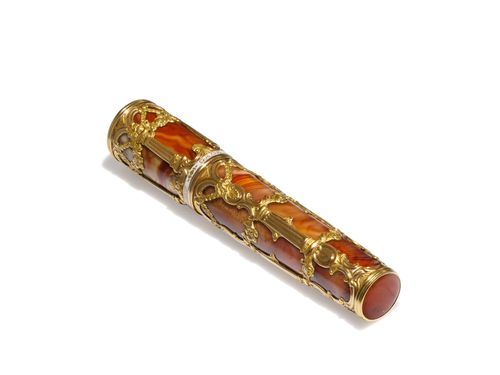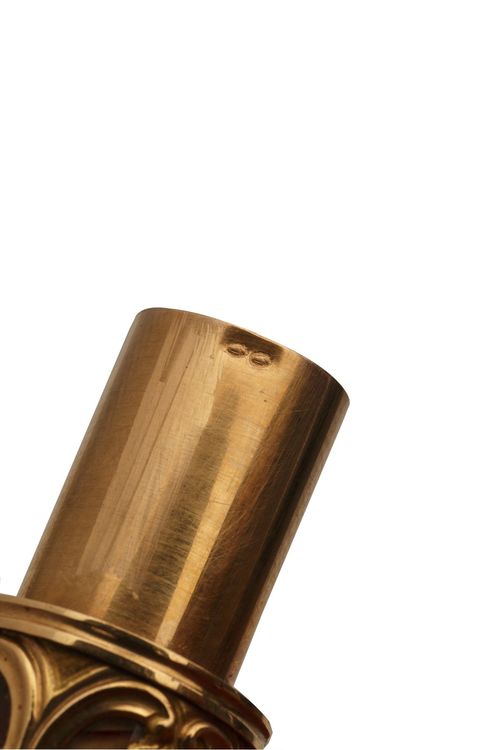Auction: 2888 - From Paris to Hong Kong
Lot: 107
48 x 36cm. (18,90 x 14,17in.) b1>ÉTUI SOUVENIR, TRAVAIL ANGLAIS DU MILIEU DU XVIIIe SIÈCLE
De forme légèrement tronconique en cornaline, appliqué d'une monture en or jaune ciselé au repercé de pilastres cannelés, arceaux feuillagés, coquilles, guirlandes de laurier ou de fleurs, le couvercle ceinturé de la devise " GAGE DE MON AMITIÉ " émaillé en champlevé sur fond blanc ; accidents et fêles
H. : 11 cm
Poids brut : 55,11 gr.
18 k (750)
Poinçons :
- Poinçon d'importation, or " Le hibou ", (frappé deux fois), toute origine provenant des pays non contractants, depuis 1893.
AN ENGLISH GOLD AND CAR NELIAN ETUI, MID 18th CENTURY
Slightly conical, carnelian and yellow chiseled gold with fluted pilasters, shell, laurel leaf or flowers swags, the lid enamel inscribed "GAGE DE MON AMITIÉ" on a white background; accidents and cracks
H.: 4 ¼ in.
Gross weight: 55, 11 gr.
18 k (750)
Hallmarks :
- Mark for gold imported from countries without custom conversions with France, from 1893 onward ; owl (struck twice)
Les étuis à épingles, connus à Paris depuis le Moyen-Âge et la Renaissance, faisaient partie des ustensiles de couture et étaient fabriqués jusqu'au XVIIe siècle par la corporation des aiguilleurs et épingliers(3). Avec l'emploi des matériaux précieux, tels l'or, l'agate ou la cornaline, comme sur notre étui, leur réalisation devint au XVIIIe siècle l'apanage des maîtres orfèvres.
ÉTUIS À ÉPINGLES CONSERV ÉS DANS LES COLLECTIONS
Notre étui présente un décor repercé de pilastres sur fond de cornaline très similaire à un autre étui à aiguilles monté sur fond d'agate, faisant partie des collections Rothschild, au Waddesdon Manor(1) (Fig. a). Comme le nôtre, il porte lui-aussi une inscription en français : L'amitié en fait le prix. Selon Grandjean et Piacenti, ce type d'objet précieux aurait pu être exécuté aussi bien en France qu'en Angleterre(2). Le Louvre possède lui aussi deux de ces étuis à aiguilles(4), au sujet desquels Grandjean notait en 1981 que depuis peu, on attribue volontiers à l'Angleterre des années 1760-1770 ce genre d'objets dont plusieurs exemples sont connus, comportant ou non une devise galante française, réservée en or sur bande d'émail blanc, et fixée sur le bord du couvercle. Le musée Cognacq-Jay possède un étui formant lunette, orné comme le nôtre de pilastres repercés à jour et de médaillons de fleurettes sur fond d'agate grise(5), alors qu'un autre étui à cire présentant lui-aussi un décor de colonnes cannelées et de guirlandes en or sur fond d'agate veinée, ayant appartenu à la reine Eugenia-Victoria, épouse du roi d'Espagne Alphonse XIII et petite-fille de la reine Victoria, se trouvait dans le commerce de l'art(6).
-1- Serge Grandjean, Kirsten Aschengreen Piacenti et all., The James A. de Rothschild Collection at Waddesdon Manor. Gold Boxes and Miniatures of the Eighteenth Century, Fribourg, Office du Livre, 1975, cat. 19.
-2- Un étui de l'anc. coll. Bernard-Franck portait l'inscription Nul plaisir sans vous, vente, Paris, galerie Georges Petit, 20-22 mai 1935, n°35 ; sur un autre, de l'anc. coll. Gabriel Cognacq, l'inscription était Votre amitié me suffit, vente Paris, Drouot, 11-13 juin 1952, n°210, cités par Serge Grandjean, Kirsten Aschengreen Piacenti et all., ibid., p. 51.
-3- Savary des Bruslons, Dictionnaire universel du commerce, Copenhague, 1759, vol. Ier, p. 474.
-4- Inv. R 475 et OA 10637, voir Serge Grandjean, Catalogue des tabatières, boîtes et étuis des XVIIIe et XIXe siècles du musée du Louvre, Paris, RMN, 1981, cat. 485-486, p. 313.
-5- Inv. J. 569, voir José de Los Llanos, Christiane Grégoire, Musée Cognacq-Jay. Les collections. Boîtes en or et objets de vertu, Paris musées, 2011, cat. 191, p. 384-385.
-6- Vente, Versailles, hôtel Rameau, Me Blache, 15 mars 1981, n°69.
Figure a : Anonyme, Etui à aiguilles, Angleterre, vers 1760-1770, or et or émaille sur fond d'agate, L. 11 cm, Collection James A. de Rothschild, Waddesdon Manor
The pin cases, known in Paris since the Middle Age and Renaissance, were part of a group of seaming instruments whose production had been entrusted until the 17th century to the corporation of the Aiguilleurs and Epingliers(3). During the 18th century, with the use of precious metals such as gold, agate or cornelian, as it is the case of our étui, their production became an exclusive prerogative of the greatest goldsmiths.
PIN CASES IN MUSEUMS AND PRIVATE COLLECTIONS
Our étui presents a pilaster-shaped decor on a cornelian background similar to that found on another étui à aiguilles mounted on an agate background, part of the Rothschild collections at the Waddesdon Manor(1 )(Fig. a). Such as the exemplary that we offer for sale, the Waddesdon Manor étui is characterized by a French inscription: L'Amitié en fait le prix. According to Grandjean and Piacent, this type of precious object could have been realized in France as well as in England(2). The Louvre keeps in its collections two étuis à aiguilles(4 ); in 1981 Grandjean noted that recently, we attribute to English production of the years 1760-1770 this type of objects, some of which bear a gold engraved French romantic motto on white enamel, fixed on the cover's rim. The Cognacq-Jay Museum, has an étui formant lunette decorated like our exemplary with pilasters and floral medallions on a grey agate background(5). Another comparable étui, that belonged to Queen Eugenia-Victoria, wife of King Alphonso XIII of Spain and niece of Queen Victoria appeared in the art market in the past few years(6).
-1- Serge Grandjean, Kirsten Aschengreen Piacenti et all., The James A. de Rothschild Collection at Waddesdon Manor. Gold Boxes and Miniatures of the Eighteenth Century, Fribourg, Office du Livre, 1975, cat. 19.
-2- An étui of the Bernard-Franck collection bearing the inscription Nul plaisir sans vous, was sold in Paris, galerie Georges Petit, 20-22 Mai 1935, n°35 ; on another, coming from the collection Gabriel Cognacq, the inscription was : "Votre amitié me suffit", sale in Paris, Drouot, 11-13 June 1952, n°210, quoted by Serge Grandjean, Kirsten Aschengreen Piacenti et all., ibid., p. 51.
-3- Savary des Bruslons, Dictionnaire universel du commerce, Copenhague, 1759, vol. Ier, p. 474.
-4- Inv. R 475 et OA 10637, cfr. Serge Grandjean, Catalogue des tabatières, boîtes et étuis des XVIIIe et XIXe siècles du musée du Louvre, Paris, RMN, 1981, cat. 485-486, p. 313.
-5- Inv. J. 569, cfr. José de Los Llanos, Christiane Grégoire, Musée Cognacq-Jay. Les collections. Boîtes en or et objets de vertu, Paris musées, 2011, cat. 191, p. 384-385.
-6- Sale in Versailles, hôtel Rameau, Me Blache, 15 March 1981, n°69.
Fig. a : Anonymous, Etui à aguilles, England, circa 1760-1770, gold and enameled gold on an agate background, James A. de Rothschild Collection, Waddesdon Manor.
Estimate
HK$30,000 to HK$50,000







